“In the Fields of Empty Days: Intersections of Past and Present in Iranian Art,”
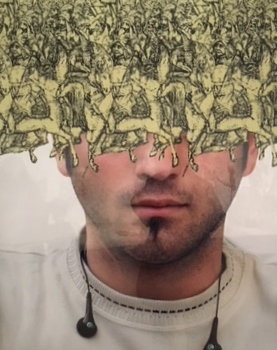
“In the Fields of Empty Days: The Intersection of Past and Present in Iranian Art” at The Los Angeles County Museum is a show on a crucial topic. Although much of the work is contemporary, note that the title does not say that. Tirafkan’s image speaks volumes of the intersection of past and present that is the theme of the exhibition: the young man is blinded by the warriors of the past, his earbuds hanging around his neck.
As curated by Linda Komaroff, it includes photography, both historic and contemporary, drawing, video, valuable manuscript pages, historical paintings, sculpture, and animations. Only a few of these artists have been shown in the US before ( note the Gray Art Gallery in New York City has an outstanding collection of Iranian modern art)

from the Series” Underground”
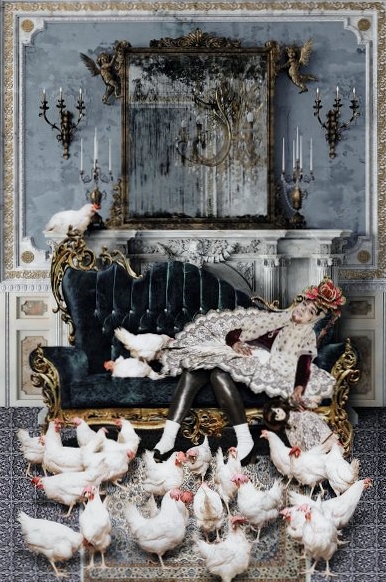
The curator’s decision to have absolutely no informative labels was slammed by the Washington Post critic. I disagree with that point of view. It was intriguing how much we engaged with these extremely political works without information. We could understand the critique in the work without polemic. Look at the work above. From the title it is obvious what is happening, the British Ambassador holds a leash and a whip, the Shah is wearing female clothes.
Many of the works are in the permanent collection of the museum, shaped by the same perspectives seen in the exhibition. In a brilliant review published in Iran, the critic Mahsa Farhadi reveals the Orientalism that underlie the curatorial theme of past and present as well as the choice of works in the collection and in the exhibition. She sees the exhibition as overgeneralizing those categories of “past” and “present.”
The title of the exhibition is a quote from a modern poet Mehdi Akhavan-Sales’s famous poem, “The Ending of Shahnameh.”
Shahnameh, (Persian: شاهنامه )“The Book of Kings”), the famous 50,000 line Persian epic poem by Ferdowsi written in the tenth and eleventh century. Bringing back Iranian history and the Persian language, it tells the myths and history of Persia from the dawn of time to the Islamic conquest in the seventh century. Illustrated versions of the Shahnameh represent the finest examples of the art of the book. The quote from the modern poem is
“Oh, henceforth we are
Like hunchbacked, old conquerors.
On the ships of waves, sails of froth.
Our hearts bound by the memory of the lambs
of splendor, in the fields of empty days,
Our swords rusty, worn out, and weary.
Our drums, forever silent,
Our arrows, broken winged.
We are the conquerors of the cities gone with the wind
We relate the forgotten stories
In a voice too weak to come out of the chest.
Nobody will pay attention or spare a copper for our coins
As if they are of a foreign king. Or, a prince whose dynasty is overthrown.
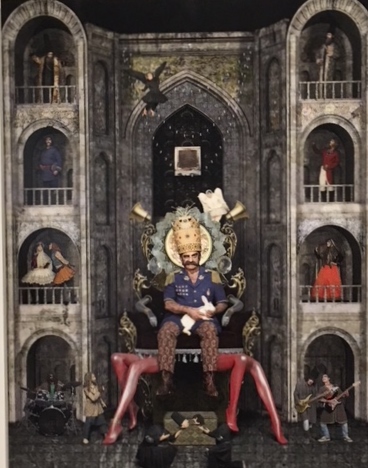
Siamak Filizadeh’s Underground , a series of huge photographs opened the exhibition, filling a long wall and a short wall. They feature the 19th Shah Nasir al-Din Shah, imagined as ruling an underground city. This Shah, like the Ottoman shahs of this time, engaged with Europe, and participating in modernizing. Reference is made to these trips in various ways, but the overall sense of the series is derogatory. The Shah appears ridiculous in Coronation, for example in which the throne is held up by two pairs of red stockinged legs and the shah is holding a rabbit.
The next artist who mesmerized me was Shoja Azari. He inserts video into a wall size projection of a manuscript page and a “coffee house painting” .
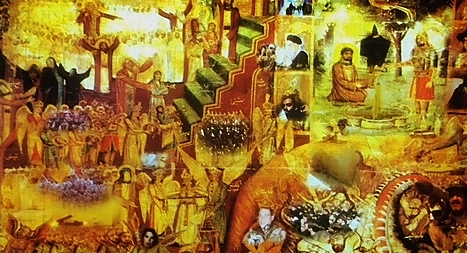
Here you can see some black and white figures in the center, as well as a nearby contemporary person. And near the upper right the famous Abu Ghraib image of torture is represented.
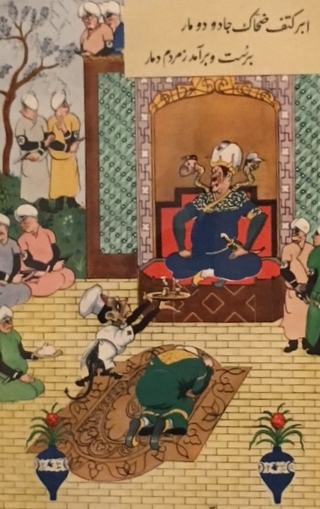
Another bizarre and fascinating combination of references appears in this propaganda poster from World War II based on the Shahnama with Goebbels as Satan as cook as monkey. It is drawn from an actual event in the Shahnama when Satan embeds himself as a cook at the court then through bribery enters the shoulders of the Shah Zahhak as serpents, causing the Shah to do many evil acts throughout his reign.
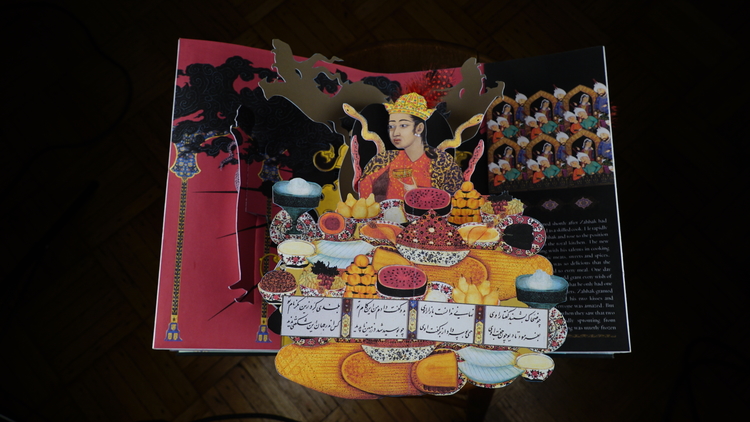
There is a wonderful cut out paper pop up of this story. Cut out artist is Simon Arizpe, amazing pop up book artist.
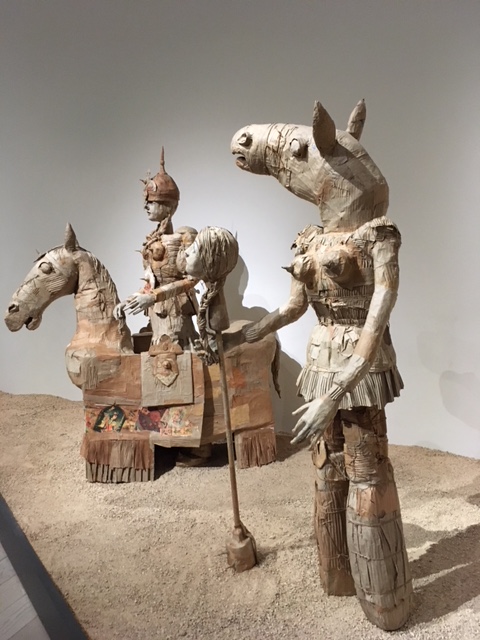
One of my favorite pieces was Yasmin Sinai, a large ensemble of cardboard figures, almost life size recounting the story of a female warrior from the Shahnama.“But one of those within the fortress was a woman, daughter of the warrior Gazhdaham, named Gordafarid. When she learned that their leader had allowed himself to be taken, she found his behaviour so shameful that her rosy cheeks became as black as pitch with rage. With not a moment’s delay she dressed herself in a knight’s armour, gathered her hair beneath a Rumi helmet, and rode out from the fortress, a lion eager for battle. She roared at the enemy ranks, “Where are your heroes, your warriors, your tried and tested chieftains?”
There were not many women in the exhibition. Aside from Yasmin, they were familiar, Shirin Neshat and Shadi Ghadirian for example we know well.
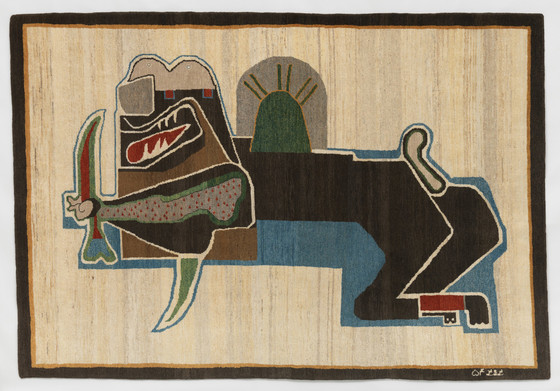
Also familiar were Parviz Tanavoli, although best known as a sculptor and here seen in a painting and weavings.
This work by Fereydoun Ave was also familiar, another reference to both the male wrestling tradition and the Shahnameh epic hero Rustam.
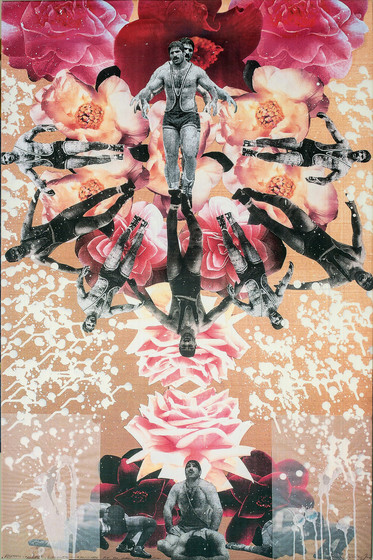
The theme of male wrestling appeared repeatedly.
There were also stunning works by other well known Iranian modernists such as Charles Hossein Zenderoudi and Khosrow Hassanzadeh as well.
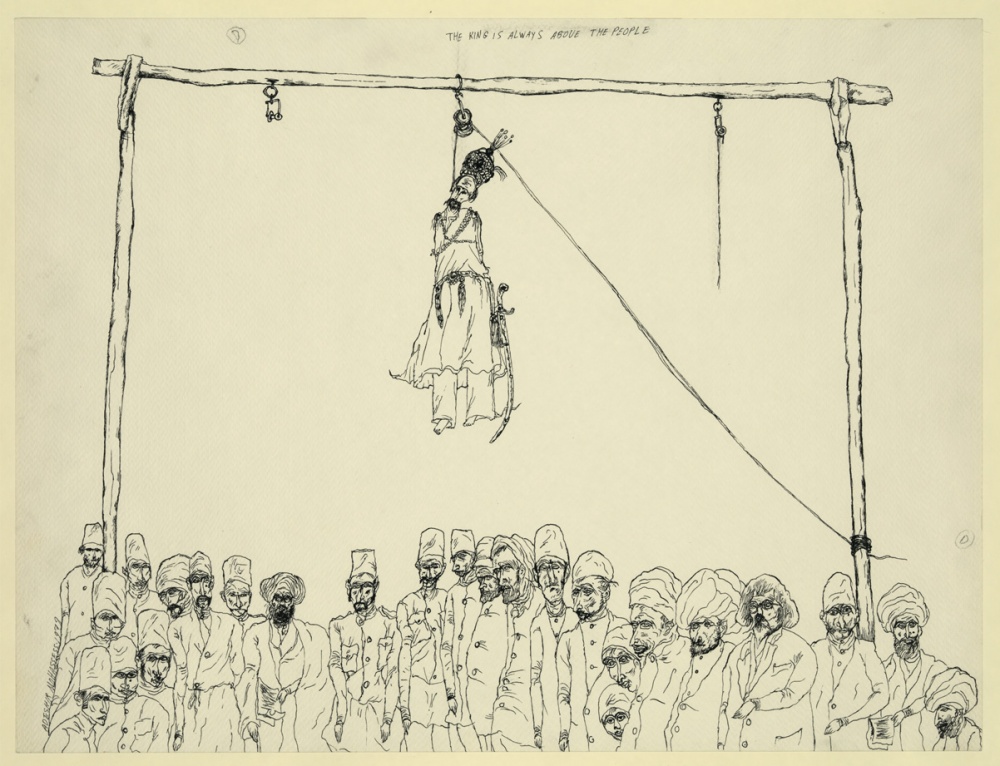
The juxtapositions of various epochs of art continued in the intricate and sardonic drawings of Ardeshir Mohassess, in a series from the 1970s borrowed from the Library of Congress! He uses late Qajar imagery to make reference to the Shah’s demise in the 1979 revolution.
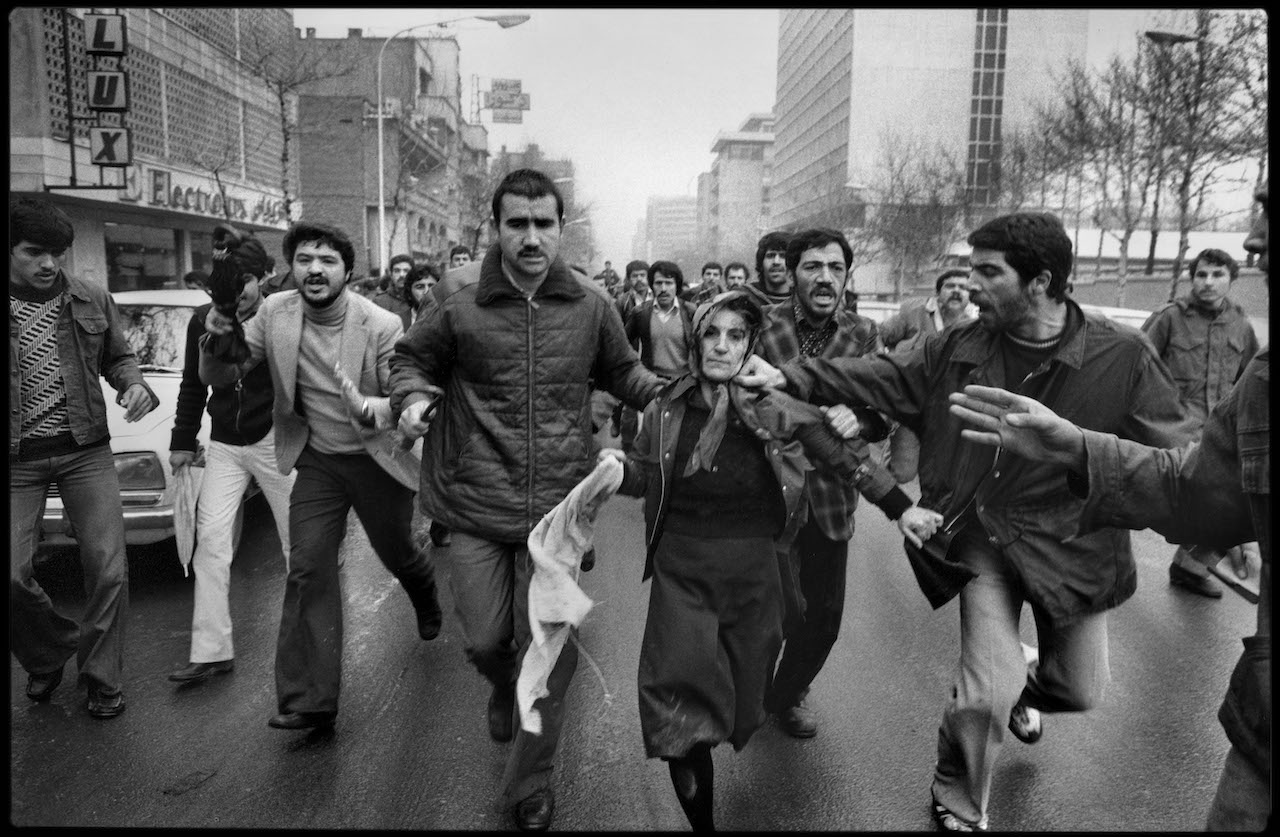
After a demonstration at the Amjadiyeh Stadium in support of the Constitution and of Shapour BAKHTIAR, who was appointed Prime Minister by the Shah before the left the country, a woman, believed to be a supporter of the Shah is mobbed by a revolutionary crowd.
See also ABA1979006W00011/05AR
That revolution and its convolutions came alive in the famous photographs of Abbas (above) , Kaveh Golestan, and Maryan Zandi. We see both the protests of the Shah and his supporters in mass crowds and up close.
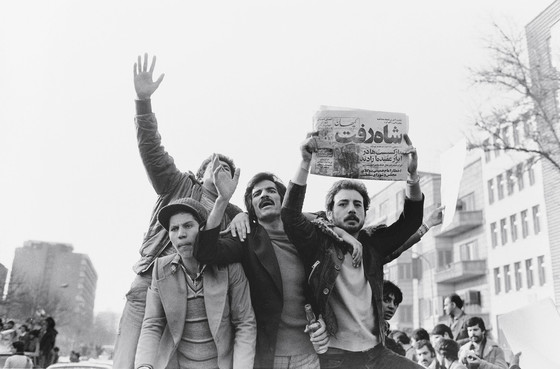
As with all revolutions ( such as the Arab spring) , the joy led to tragedy, as the Islamic leaders followed an oppressively conservative direction subsequently challenged by the same people who were happy at the departure of the shah.
One of my favorite images that focuses on the craziness of the Revolution is by Ramin Haerizadeh
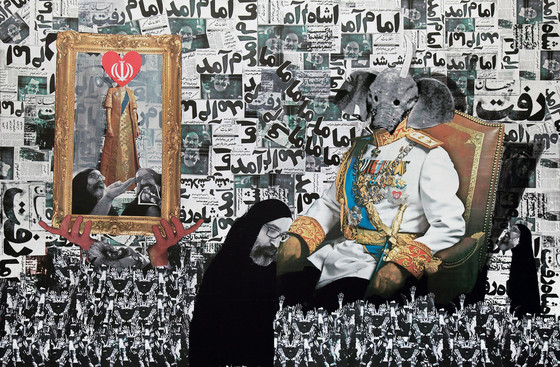
Perhaps that is why the curator chose to include fabulous animations.
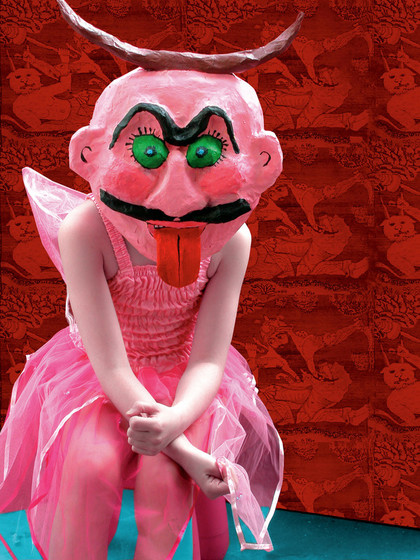
Or the imaginative work of Makekeh Nayiny
Although they also make reference to early myths, the metaphors of contemporary life and politics are obvious. In All in the Pink, Nayiny gives us a child in a grotesque mask, a demon mask, a reference to the demons defeated by the hero Rustam in the Shahnama. Now though this disturbing masked child challenges us to wonder who the real demon actually is (you can see the historical depiction in the wallpaper in the background).
This subtle show offered us new insights into Iran. Most of the art works were direct satires or protest masked in historical and mythical themes. The photographs from the time of the revolution we now see in the light of subsequent events as deeply sad and ironic.
Given the one dimensional knowledge that most people in the US have of Iran today, visiting this exhibition provides an opportunity to understand the complexity of Iranian history as well as its present moment. The resonant phrase “In the Fields of Empty Days,” invokes a desolate end to an empire that can apply to not only the situation in Iran, but also elsewhere on the planet as misguided policies kill, torture and brutally damage humans and the earth.
Full Photo credits:
Sadegh Tirafkan The Loss of Our Identity no. 1 Boy 2007, fromthe Series, The Loss of our Identity, 2007, chromogenic print, Brooklyn MuseumMuseum Collection Fund, by exchange
Siamak Filizadeh, The British Ambassador, The Coronation and Anis al-Daula from the series “Underground”, 2014, inkjet print, Los Angeles County Museum of Art, purchased with funds provided by Kitzia and Richard Goodman through the 2016 Collectors Committee, © Siamak Filizadeh, photo © Museum Associates/LACMA
Shoja Azari The Day of the Last Judgment (Coffee House Painting,)
2009 video projection, The Museum of Contemporary Art, Los Angeles, gift of Leila Heller
Kevin Evan Marengo, Ahriman-Goebbels disguised as Zahhak-Hitler’s cook causes serpents wiht the faces of Mussolini and Tojo to grow out of his shoulders, 1942, offset lithograph on paper, LACMA purchased with funds provided by Shidan Taslimi
Yasmin Sinai, The Act of Gurdafarid, the Female Warrior, 2015 cardboard paper glue, LACMA, gift of Lynda and Stewart Resnick through the 22017 Collections Committee
Parviz Tanavoli, Lion and Sword III, 1976, Bijar weave, 62 1/4 × 91 in., Los Angeles County Museum of Art, gift of Hope Warschaw through the 2018 Collectors Committee, courtesy of the artist, © Parviz Tanavoli, photo © Museum Associates/LACMA
Fereydoun Ave, Untitled from the series Rostam in Late Summer—Revisited, 2009, inkjet print on canvas, 59 1/2 × 39 1/2 in., Mohammed Afkhami Foundation, Switzerland, © Fereydoun Ave, photo courtesy of Janet Rady Fine Art
Ardeshir Mohassess, The King is always above the people from the series Life in Iran, 1978, ink on paper, Prints an Photographs Division, Library of Congress, Washington, D.C.
Kaveh Golestan, The Shah Left, 1979, printed 2015, gelatin silver print, 24 × 30 in., Los Angeles County Museum of Art, gift of the Estate of Kaveh Golestan, © Estate of Kaveh Golestan, digital image © Museum Associates/LACMA
Ramin Haerizadeh, He Came, He Left, He Left, He Came, 2010, mixed media and collage on canvas, 78 3/4 × 118 1/8 in., The Farook Collection, Dubai, © Ramin Haerizadeh, photo courtesy Gallery Isabelle van den Eynde
Malekeh Nayiny, All in Pink, 2007, dye coupler print, 47 1/4 × 35 3/8 in., Los Angeles County Museum of Art, purchased with funds provided by Nina Ansary, © Malekeh Nayiny
This entry was posted on June 25, 2018 and is filed under Art and Politics Now, art criticism, Contemporary Art, Iran, Iranian protests, Iranian Women, Uncategorized.








